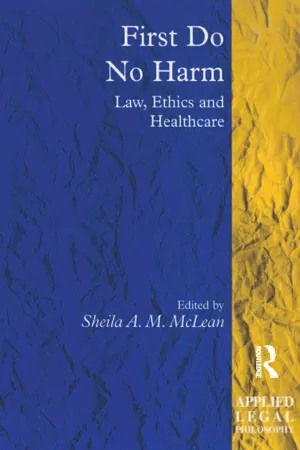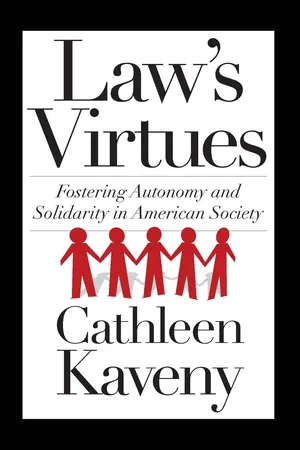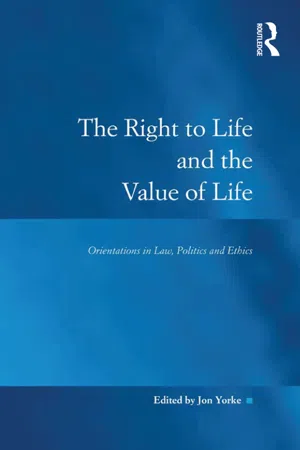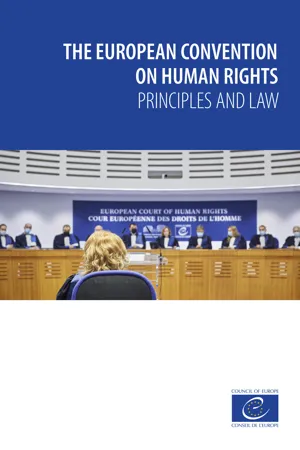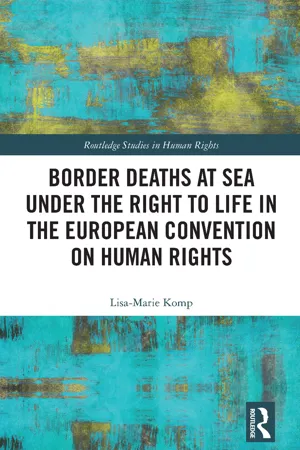Law
Right to Life
The right to life is a fundamental human right that protects individuals from being unlawfully deprived of their lives. It is often enshrined in national constitutions and international human rights instruments. This right encompasses not only the right to be free from arbitrary execution, but also the obligation of states to take positive measures to protect individuals' lives.
Written by Perlego with AI-assistance
Related key terms
8 Key excerpts on "Right to Life"
- Joo-Young Lee(Author)
- 2016(Publication Date)
- Routledge(Publisher)
The broad interpretation of the Right to Life is reiterated by the Commission in the case of Tavares v. France. 89 The African Commission on Human and Peoples’ Rights has also reasoned that, inter alia, pollution and environmental degradation ‘to a level humanly unacceptable’ constituted violations of the Right to Life. 90 Further, the Inter-American Court, in the case of Morales v. Guatemala, has affirmed that the Right to Life requires not only negative obligations but also a positive obligation ‘to take all necessary measures to protect and preserve the Right to Life. 91 Two judges of the Inter-American Court, in a joint concurring opinion on the same case, clarify that the language ‘arbitrary deprivation of life’ in Article 4 of the ACHR extends to ‘the deprivation of the right to live with dignity’. 92 Access to Essential Medicines The jurisprudence of the UN Human Rights Committee and regional human rights bodies confirms that the Right to Life encompasses access to minimum conditions necessary for survival. F. Menghistu argues that ‘[s]urvival requirements [for the Right to Life] are minimum requirements which are related to the concept of basic needs’. 93 Following this line of argument, access to essential medicines, defined earlier in this chapter, constitutes one of the minimum conditions for survival, and thus a part of the Right to Life. The scope of access to essential medicines is narrower than the scope of access to life-saving medicines. Life-saving medicines entail very expensive ones that can be made accessible to only a small number of people even in resource-rich countries. In a number of national courts, the Right to Life has been successfully invoked, along with the right to health, in cases where a particular treatment was potentially life saving or life sustaining- eBook - ePub
- Peter Halstead(Author)
- 2014(Publication Date)
- Routledge(Publisher)
The case law, domestic and European, demonstrates the wide scope of this subject, from abortion and separation of conjoined twins to euthanasia and removal of life support from persons in a persistent vegetative state (PVS). Other aspects involve self-defence, deprivation of life whilst in custody, war and circumstances where States may or may not have failed in their positive duty to create and permit conditions where life is protected. As suggested above, sometimes philosophical and ethical issues arise such as identifying the precise moment at which life begins or ends, an important consideration in modern medical research and practice.The Right to Life is contained in Article 2 as follows: ARTICLE‘2(1) Everyone’s Right to Life shall be protected by law. No-one shall be deprived of his life intentionally save in the execution of a sentence of a court following his conviction of a crime for which this penalty is provided by law.2(2) Deprivation of life shall not be regarded as inflicted in contravention of this Article when it results from the use of force which is no more than absolutely necessary in: (a) defence of any person; (b) order to effect a lawful arrest or to prevent the escape of a person lawfully detained; (c) action lawfully taken for the purpose of quelling a riot or insurrection.’ The Right to Life is fundamental to all human rights and in a sense can be regarded as a pre-requisite to all the other substantive rights, but as Article 2(2) clearly shows there are circumstances where deprivation of life can be justified. The most obvious one is self-defence but Article 2(2)(a) encompasses defence of any person from unlawful violence (thus going beyond self-defence) and is not qualified by the words ‘absolutely necessary’ as one might expect it to be if enacted in a domestic context. - eBook - ePub
First Do No Harm
Law, Ethics and Healthcare
- Sheila A. M. McLean(Author)
- 2016(Publication Date)
- Routledge(Publisher)
Quite different consequences follow if we explore a third way of approaching the ‘right to die’, namely through the thesis that this follows from the ‘Right to Life’. It may be argued that, if a person has the Right to Life it follows as a matter of logic that the person has the right to die. To have a right means that I am entitled to have or do something but allows not only the waiving of that right but the right not to have or do that something.This is a fallacious argument in that only some rights are ‘option’ rights in the sense that they their correlative duties can be called in or waived at the request of the right-bearer.20The euthanasia option cannot be logically deduced from the Right to Life. Indeed, as currently understood, in law, the Right to Life excludes the euthanasia option, since it correlates with the duty to preserve life.However, neither is it necessary to interpret the Right to Life in terms of what is usually referred to as the ‘sanctity of life’. Excluding religious interpretations of the sanctity of life along the lines that life is given by God and may not, therefore, be taken away by anybody but God (the assumption being that God does not operate through human beings in this regard), I will take ‘the sanctity of life’ to mean a combination of three claims: (1) that there is an absolute right not to be killed, (2) that there is no entitlement to waive that right, and (3) that there is a duty not to kill oneself.So understood, the ‘Right to Life’ must be viewed as involving a prohibition of the euthanasia option. Indeed, it seems to be a glaring exception to my thesis that the strongest anti-euthanasia arguments are consequentialist in form. It is indeed a knockout argument against involuntary euthanasia. However, I would argue that this version of the Right to Life is not a strong argument if it is taken to ascribe to human beings an absolute right that cannot be waived or overridden in any circumstances.If the argument is that God has given life and only God can, therefore, take it away, then the right in question is God’s, not ours (although the duties fall on all other beings capable of killing). If it is a secular right, directed to protecting the interests of the right-holder, than it is the right-holders right to waive that right when they believe it in their interests so to do. Further such a right does not have any purchase and does not apply if the individuals concerned have no interests (as when they are permanently lacking in any consciousness), or when it is not in their interests to continue living (as in the case of unrelievable severe pain). - eBook - ePub
Moral Traditions series
Fostering Autonomy and Solidarity in American Society
- Cathleen Kaveny(Author)
- 2012(Publication Date)
- Georgetown University Press(Publisher)
57CONCLUSION
While the Right to Life may be “fundamental” in the order of logic, the order of practicality demands a multifaceted strategy to protect that right in Western liberal democracies where abortion has long been legal and widely used. Recognizing lawmaking’s nature as a practical activity designed to further the common good leads to the insight that pro-life legislators must broaden their focus beyond the criminal law. Too narrow a strategy will backfire and end up harming rather than promoting the overall well-being of the entire community, including the elderly and the unborn. Thus efforts to use the law to inculcate the value of unborn life must widen their focus beyond the criminal code, which details only one of many types of legal norms in our complex, postindustrial society. As Mary Ann Glendon notes in her groundbreaking book Abortion and Divorce in Western Law , reducing the number of abortions requires taking a long, hard look at far more than criminal law. Describing the protection for unborn life mandated by the West German Basic Law, she noted that “what is important is that the totality of abortion regulations—that is, all criminal, public health and social welfare laws related to abortion—be in proportion to the importance of the legal value of life, and that, as a whole, they work for the continuation of the pregnancy.”58NOTES
This chapter has its seeds in M. Cathleen Kaveny, “How Views of Law Influence the Pro-Life Movement,” Origins , no. 34/35 (February 17, 2005): 560–65.1 . Roe v. Wade , 410 US 113 (1973). Although Planned Parenthood v. Casey , 505 US 833, 846 (1992) significantly modified the framework that the Court used to assess abortion, it also reaffirmed Roe - eBook - ePub
The Right to Life and the Value of Life
Orientations in Law, Politics and Ethics
- Jon Yorke(Author)
- 2016(Publication Date)
- Routledge(Publisher)
For the ‘pro-choice’ position see, Pro-Choice Majority, www.prochoicemajority.org.uk, and Prochoice, http://prochoice.com. Indeed, the issue of abortion not only involves antagonistic debates surrounding the Right to Life of the foetus, but also, the Right to Life of physicians, as is witnessed when pro-life activists kill pro-choice physicians administering abortions. An example in the United States was the shooting of Dr George Tiller in Kansas on 31 May 2009. 4 This collection is not concerned with identifying any per se ‘meaning of life.’ However, the chapters in this book do provide a certain level of ‘meaning’ within the specific juridical, political and philosophical boundaries with which the contributors are concerned. For the appropriateness of the question of an inherent meaning of life see the excellent introductions by Cottingham 2003 and Eagleton 2007, and see also Grayling 2001 and Belshaw 2005. For an overview of the converse issues surrounding ‘death,’ see, Enright 1983. 5 Other international instruments providing enumerations are the: American Declaration on the Rights and Duties of Man, article 1; African Charter of Human and People’s Rights article 4; Arab Charter on Human Rights, article 5. 6 Other international instruments providing definitions are the: European Convention on Human Rights, article 2(1); American Convention on Human Rights article 4; Commonwealth of Independent States Convention on Human Rights and Fundamental Freedoms, article 2. 7 One way around this problem is the adoption of additional instruments and most of the contributors to this collection engage with this possibility. 8 General Comment 6(16), UN Doc. CCPR/C/21/Add.1. 9 Annual Report of the Inter-American Commission on Human Rights, 1986-1987, OAS Doc. OEA/Ser.L/V/II.71, doc. 9 rev. 1, p - Carla M. Buckley, Krešimir Kamber, Pamela McCormick, David J. Harris(Authors)
- 2022(Publication Date)
- Council of Europe(Publisher)
First, the scope of the Right to Life marked by the beginning of life to its end remains sensitive to consensus among European states and developments in scientific knowledge. Second, the obligation to protect life continues to be a fertile basis for Convention case law. While it stops short of guaranteeing the necessities of life, such as housing and universal healthcare, the Court applies a dynamic interpretative approach that addresses the many threats to life that exist in Europe today, such as domestic violence, and the vulnerability of persons in detention or hospitalised. Third, the content of the duty to investigate loss of life continues to develop in terms of its requirements in differing forensic and operational contexts and the need for interstate co-operation in the sharing of evidence. Fourth, the circumstances justifying the taking of life by states are undergoing transformation. This aspect can be seen most clearly in relation to the death penalty, which was so entrenched in many European domestic penal laws in 1950 has all but been removed as a permissible deprivation of life by amendments to the text of Article 2 through operation of Protocol No. 6 and No. 13 and in the light of recent European state practice. Furthermore, the Court has devised new evidential rules to address the phenomenon of “disappeared persons” in Europe, and changes in operational contexts for law enforcers, such as terrorist and urban guerrilla policing operations, continue to raise issues about the duties of a democratic state. Finally, there is continued uncertainty as to the relationship between international humanitarian law and the Right to Life under Article 2 although the Court has considered many cases from armed conflict situations, such as from south-east Turkey, South Ossetia and Chechnya- eBook - ePub
- Howard Davis(Author)
- 2014(Publication Date)
- Routledge(Publisher)
The importance of ‘life’ is already recognised. The point of human rights law is to require states to protect the Right to Life that is already established in human custom and in religious or moral beliefs. The UN’s International Covenant on Civil and Political Rights (ICCPR), for instance, says that ‘Every human being has the inherent Right to Life’. Similarly the first sentence of Article 2 ECHR says — ‘Everyone’s Right to Life shall be protected by law’. Article 2, therefore, imposes on states a range of negative and positive duties required to guarantee that the Right to Life is respected. No Intentional killing Article 2 is explicit about these duties in one respect. The second sentence says that ‘no one shall be deprived of his life intentionally …’. Thus states must have laws which define ‘murder’ and which provide the means by which it can be investigated, prosecuted and punished. In particular, state agents (such as police, security services and the military) must not intentionally kill, except in very limited circumstances which are discussed below. Warfare, of course, involves intentional killing. As a general rule states cannot use lethal force (force intending to kill) just because the country is facing a state of emergency. Suspending or ‘derogating’ from rights, which is allowed if done consistently with Article 15, is not generally permissible for Article 2 (derogation is discussed in Chapter 4) - Lisa-Marie Komp(Author)
- 2022(Publication Date)
- Routledge(Publisher)
The first sentence of Article 2 ECHR reads: ‘Everyone’s Right to Life shall be protected by law.’ From the Court’s case law, it can be discerned that this requirement comprises an overall duty to install a legislative and administrative framework that is geared towards the protection of life in all sectors of society. As such, the duty to protect the Right to Life by law can also be seen as part of the duty to prevent the loss of life. Nevertheless, it will be discussed separately here. The importance of the requirement to protect the Right to Life by law for the safeguarding of the Right to Life transpires from the following passage:The positive obligation to take all appropriate steps to safeguard life for the purposes of Article 2 (see paragraph 71 above) entails above all a primary duty on the State to put in place a legislative and administrative framework designed to provide effective deterrence against threats to the Right to Life (see, for example, mutatis mutandis, Osman, cited above, p. 3159, § 115; Paul and Audrey Edwards, cited above, § 54; İlhan v. Turkey [GC], no. 22277/93, § 91, ECHR 2000-VII; Kılıç v. Turkey, no. 22492/93, § 62, ECHR 2000-III; and Mahmut Kaya v. Turkey, no. 22535/93, § 85, ECHR 2000-III).83It is, thus, clear that the Court attaches great importance to the duty to ensure that the State’s legislative and administrative framework is designed so as to contribute to the protection of the Right to Life.2.1 Scope of Application
As with the duty to prevent the loss of life more generally, the Court will only consider a situation under the duty to protect the Right to Life by law if the applicants have successfully surpassed the hurdle of Article 1 ECHR. As a result, the Court has not made explicit considerations regarding the question of whether the duty to protect the Right to Life by law must also cover threats to life outside the territory of a State. Possibly, however, the duty to do so in regard to all threats to life that may arise within or result in the death of a person within the State’s territory may have the practical effect of also minimizing threats to life that occur beyond the State’s territory.
Index pages curate the most relevant extracts from our library of academic textbooks. They’ve been created using an in-house natural language model (NLM), each adding context and meaning to key research topics.


